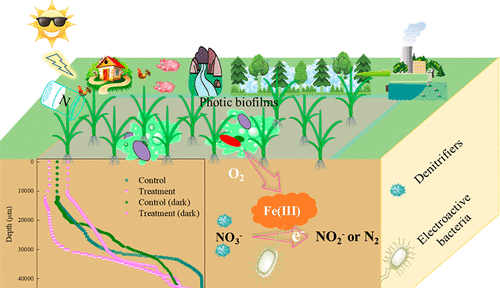当前位置:
X-MOL 学术
›
ACS Earth Space Chem.
›
论文详情
Our official English website, www.x-mol.net, welcomes your
feedback! (Note: you will need to create a separate account there.)
Photic Biofilms Mediated Distant Nitrate Reduction at the Soil–Water Interface of Paddy Fields
ACS Earth and Space Chemistry ( IF 2.9 ) Pub Date : 2021-04-14 , DOI: 10.1021/acsearthspacechem.1c00040 Ningyuan Zhu 1 , Xuechen Zhang 2 , Shanshan Yang 3 , Chunquan Li 4 , Jun Qiao 1 , Jun Tang 1
ACS Earth and Space Chemistry ( IF 2.9 ) Pub Date : 2021-04-14 , DOI: 10.1021/acsearthspacechem.1c00040 Ningyuan Zhu 1 , Xuechen Zhang 2 , Shanshan Yang 3 , Chunquan Li 4 , Jun Qiao 1 , Jun Tang 1
Affiliation

|
Photic biofilms widely exist on the surface of paddy soil and play a key role in nutrient transformation and accumulation in the soil–water interface. However, whether and how photic biofilms affect nitrogen cycles in the subsoil remained unclear. This study investigated the processes and mechanisms of nitrate reduction in waterlogged paddy soil in the presence (treatment) or absence (control) of photic biofilms. The observed nitrate reduction rate constant (kobs) in the treatment soil increased 1.7 times compared with control. This accelerated kobs was attributed to the synergistic effect between poorly crystalline Fe minerals and autotrophic denitrifiers in soil, which was highly related to the presence of the photic biofilms. Photic biofilms aggravating daily redox oscillations at the soil–water interface promoted the formation of poorly crystalline Fe minerals available for microorganisms. Thus, photic biofilms increased the relative abundance of electroactive bacteria (Sphingomonadaceae and Xanthobacteraceae), iron reduction bacteria (Geobacter and Ignavibacterium), and denitrifiers (Rhodanobacteraceae and Burkholderiaceae) with higher copy numbers of nirK, nirS, and nosZ genes, thereby accelerating the nitrate reduction. Additionally, poorly crystalline Fe minerals contributed to improving interfacial electron transfer ability, which improved the activity of denitrifiers. These results suggested that the photic biofilms bioelectrochemically mediated the nitrate reduction in the waterlogged paddy soil.
中文翻译:

水稻田在土壤-水界面的生物膜介导的远距离硝酸盐还原
水稻土壤表面广泛存在生物膜,在土壤-水界面的养分转化和积累中起关键作用。但是,目前尚不清楚光合生物膜是否以及如何影响底土中的氮循环。这项研究调查了在有光生物膜存在(处理)或无光(控制)的情况下,淹水水稻土中硝酸盐还原的过程和机理。与对照相比,在处理土壤中观察到的硝酸盐还原速率常数(k obs)增加了1.7倍。这加速ķ OBS这归因于结晶度差的铁矿物质与土壤中自养反硝化剂之间的协同作用,这与光生物膜的存在高度相关。在土壤-水界面的生物膜加剧了每日的氧化还原振荡,促进了可用于微生物的结晶性较弱的铁矿物质的形成。因此,光生化的生物膜增加了电活性细菌(鞘氨醇单胞菌和Xanthobacteraceae),铁还原细菌(Geobacter和Ignavibacter细菌)和反硝化剂(Rhodanobacteraceae和Burkholderiaceae)的相对丰度,其中nirK,nirS和nosZ的拷贝数更高。基因,从而加速硝酸盐的还原。另外,结晶性差的铁矿物有助于改善界面电子转移能力,从而改善了反硝化剂的活性。这些结果表明,光化学生物膜通过生物电化学方式介导了涝渍稻田中硝酸盐的减少。
更新日期:2021-05-20
中文翻译:

水稻田在土壤-水界面的生物膜介导的远距离硝酸盐还原
水稻土壤表面广泛存在生物膜,在土壤-水界面的养分转化和积累中起关键作用。但是,目前尚不清楚光合生物膜是否以及如何影响底土中的氮循环。这项研究调查了在有光生物膜存在(处理)或无光(控制)的情况下,淹水水稻土中硝酸盐还原的过程和机理。与对照相比,在处理土壤中观察到的硝酸盐还原速率常数(k obs)增加了1.7倍。这加速ķ OBS这归因于结晶度差的铁矿物质与土壤中自养反硝化剂之间的协同作用,这与光生物膜的存在高度相关。在土壤-水界面的生物膜加剧了每日的氧化还原振荡,促进了可用于微生物的结晶性较弱的铁矿物质的形成。因此,光生化的生物膜增加了电活性细菌(鞘氨醇单胞菌和Xanthobacteraceae),铁还原细菌(Geobacter和Ignavibacter细菌)和反硝化剂(Rhodanobacteraceae和Burkholderiaceae)的相对丰度,其中nirK,nirS和nosZ的拷贝数更高。基因,从而加速硝酸盐的还原。另外,结晶性差的铁矿物有助于改善界面电子转移能力,从而改善了反硝化剂的活性。这些结果表明,光化学生物膜通过生物电化学方式介导了涝渍稻田中硝酸盐的减少。











































 京公网安备 11010802027423号
京公网安备 11010802027423号